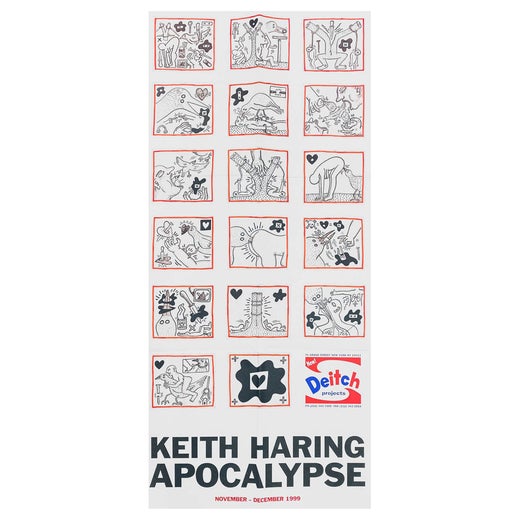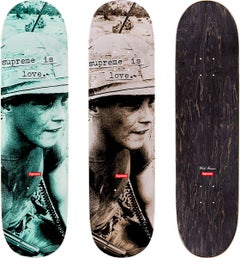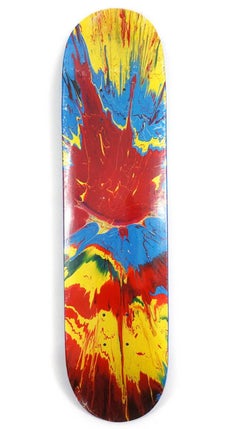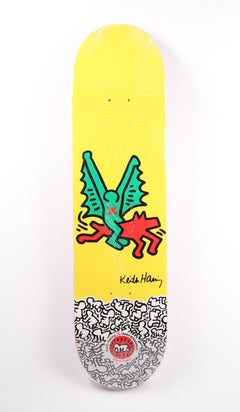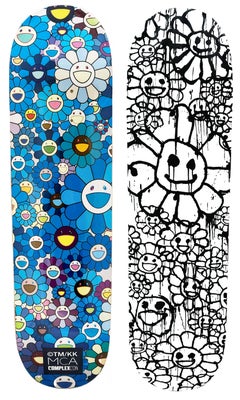Want more images or videos?
Request additional images or videos from the seller
1 of 7
(after) Keith HaringKeith Haring Skateboard Deck set of 3 works (Keith Haring skate decks)c.2012
c.2012
$1,650List Price
About the Item
- Creator:(after) Keith Haring (1958 - 1990, American)
- Creation Year:c.2012
- Dimensions:Height: 31 in (78.74 cm)Width: 8 in (20.32 cm)Depth: 1 in (2.54 cm)
- Medium:
- Movement & Style:
- Period:
- Condition:Very good.
- Gallery Location:NEW YORK, NY
- Reference Number:1stDibs: LU354310921852
(after) Keith Haring
Keith Allen Haring was an American artist whose pop art emerged from the New York City graffiti subculture of the 1980s.
About the Seller
5.0
Vetted Professional Seller
Every seller passes strict standards for authenticity and reliability
Established in 2014
1stDibs seller since 2016
4,607 sales on 1stDibs
Authenticity Guarantee
In the unlikely event there’s an issue with an item’s authenticity, contact us within 1 year for a full refund. DetailsMoney-Back Guarantee
If your item is not as described, is damaged in transit, or does not arrive, contact us within 7 days for a full refund. Details24-Hour Cancellation
You have a 24-hour grace period in which to reconsider your purchase, with no questions asked.Vetted Professional Sellers
Our world-class sellers must adhere to strict standards for service and quality, maintaining the integrity of our listings.Price-Match Guarantee
If you find that a seller listed the same item for a lower price elsewhere, we’ll match it.Trusted Global Delivery
Our best-in-class carrier network provides specialized shipping options worldwide, including custom delivery.You May Also Like
Alien Workshop x Andy Warhol Foundation Skateboard "Cow" 2011
By Andy Warhol
Located in Draper, UT
Alien Workshop Iconic Collection W/ Andy Warhol
Comes with Original Alien Skateboard sticker and wall mount.
From the Iconic Collection, depicting the...
Category
2010s Pop Art More Art
Materials
Wood, Screen
With all My Flowering Heart Skateboard Triptych, 3 Limited Edition Skate Decks
By Yayoi Kusama
Located in New York, NY
Yayoi Kusama
With All My Flowering Heart (Triptych), 2014
Set of Three (3) Separate Limited Edition numbered skate decks on 7-ply Canadian maple wood
31 × 8 × 2/5 inches (each)
Hand ...
Category
2010s Pop Art Abstract Prints
Materials
Wood, Mixed Media, Permanent Marker, Screen
$3,500
H 31 in W 8 in D 0.4 in
Shepard Fairey, Bureau of Public Works Twice Signed work on wood panel unique AP
By Shepard Fairey
Located in New York, NY
SHEPARD FAIREY
Bureau of Public Works (on Wood), 2004
Silkscreen on wood panel. Hand signed and annotated on both the recto and verso. In original handmade artist's frame.
24 × 18 in...
Category
Early 2000s Pop Art Abstract Prints
Materials
Wood, Screen
Shepard FaireyShepard Fairey, Bureau of Public Works Twice Signed work on wood panel unique AP, 2004
$10,500 Sale Price
30% Off
H 24 in W 18 in D 1.5 in
Richard Pettibone The Appropriation Warhol, Stella, Lichtenstein, Unique Signed
By Richard Pettibone
Located in New York, NY
Richard Pettibone
The Appropriation Print Andy Warhol, Frank Stella, Roy Lichtenstein, 1970
Silkscreen in colors on masonite board (unique variant on sculpted board)
Hand-signed by artist, Signed and dated on the front (see close up image)
Bespoke frame Included
This example of Pettibone's iconic Appropriation Print is silkscreened on masonite board rather than paper, giving it a different background hue, and enabling it work to be framed so uniquely.
The Appropriation print is one of the most coveted prints Pettibone ever created ; the regular edition is on a full sheet with white background; the present example was silkscreened on board, allowing it to be framed in 3-D. While we do not know how many examples of this graphic work Pettibone created, so far the present work is the only one example we have ever seen on the public market since 1970. (Other editions of The Appropriation Print have been printed on vellum, wove paper and pink and yellow paper.)
This 1970 homage to Andy Warhol, Frank Stella and Roy Lichtenstein exemplifies the type of artistic appropriation he was engaging in early on during the height of the Pop Art movement - long before more contemporary artists like Deborah Kass, Louise Lawler, etc. followed suit.
This silkscreen was in its original 1970 vintage period frame; a bespoke custom hand cut black wood outer frame was subsequently created especially to house the work, giving it a distinctive sculptural aesthetic.
Measurements:
Framed 14.5 inches vertical by 18 inches horizontal by 2 inches
Work
13 inches vertical by 16.5 inches horizontal
Richard Pettibone biography:
Richard Pettibone (American, b.1938) is one of the pioneering artists to use appropriation techniques. Pettibone was born in Los Angeles, and first worked with shadow boxes and assemblages, illustrating his interest in craft, construction, and working in miniature scales. In 1964, he created the first of his appropriated pieces, two tiny painted “replicas” of the iconic Campbell’s soup cans by Andy Warhol (American, 1928–1987). By 1965, he had created several “replicas” of paintings by American artists, such as Warhol, Roy Lichtenstein (1923–1997), Ed Ruscha (b.1937), and others, among them some of the biggest names in Pop Art. Pettibone chose to recreate the work of leading avant-garde artists whose careers were often centered on themes of replication themselves, further lending irony to his work. Pettibone also created both miniature and life-sized sculptural works, including an exact copy of Bicycle Wheel by Marcel Duchamp (French, 1887–1968), and in the 1980s, an entire series of sculptures of varying sizes replicating the most famous works of Constantin Brancusi (Romanian, 1876–1957). In more recent years, Pettibone has created paintings based on the covers of poetry books by Ezra Pound, as well as sculptures drawn from the grid compositions of Piet Mondrian (Dutch, 1872–1944). Pettibone straddles the lines of appropriation, Pop, and Conceptual Art, and has received critical attention for decades for the important questions his work raises about authorship, craftsmanship, and the original in art. His work has been exhibited at the Institute for Contemporary Art in Philadelphia, the Museum of Modern Art in New York, the Museum of Contemporary Art in Miami, and the Laguna Art Museum in Laguna Beach, CA. Pettibone is currently based in New York.
"I wished I had stuck with the idea of just painting the same
painting like the soup can and never painting another painting.
When someone wanted one, you would just do another one.
Does anybody do that now?"
Andy Warhol, 1981
Since the mid-1960s, Richard Pettibone has been making
hand-painted, small-scale copies of works by other artists — a
practice due to which he is best known as a precursor of appropriation art — and for a decade now, he has been revisiting subjects from across his career. In his latest exhibitions at
Castelli Gallery, Pettibone has been showing more of the “same”
paintings that had already been part of his 2005–6 museum retrospective,1
and also including “new” subject matter drawn from
his usual roster of European modernists and American postwar
artists. Art critic Kim Levin laid out some phases of the intricate spectrum from copies to repetitions in her review of the
Warhol-de Chirico showdown, a joint exhibition at the heyday
of appropriation art in the mid-1980s when Warhol’s appropriations of de Chirico’s work effectively revaluated “the grand
old auto-appropriator”.
Upon having counted well over a dozen
Disquieting Muses by de Chirico, Levin speculated: “Maybe he
kept doing them because no one got the point. Maybe he needed the money. Maybe he meant it when he said his technique
had improved, and traditional skills were what mattered.”
On
the other side, Warhol, in her eyes, was the “latter-day exemplar
of museless creativity”.
To Pettibone, traditional skills certainly
still matter, as he practices his contemporary version of museless creativity. He paints the same painting again and again,
no matter whether anybody shows an interest in it or not. His
work, of course, takes place well outside the historical framework of what Levin aptly referred to as the “modern/postmodern wrestling match”,
but neither was this exactly his match
to begin with.
Pettibone is one of appropriation art’s trailblazers, but his diverse
selection of sources removes from his work the critique of the
modernist myth of originality most commonly associated with
appropriation art in a narrow sense, as we see, for example, in
Sherrie Levine’s practice of re-photographing the work of Walker
Evans and Edward Weston. In particular, during his photorealist
phase of the 1970s, Pettibone’s sources ranged widely across
several art-historical periods. His appropriations of the 1980s
and 1990s spanned from Picasso etchings and Brancusi sculptures to Shaker furniture and even included Ezra Pound’s poetry.
Pettibone has professed outright admiration for his source artists, whose work he shrinks and tweaks to comic effect but, nevertheless, always treats with reverence and care. His response
to these artists is primarily on an aesthetic level, owing much
to the fact that his process relies on photographs. By the same
token, the aesthetic that attracts him is a graphic one that lends
itself to reproduction. Painstakingly copying other artists’ work by hand has been a way of making
it his own, yet each source is acknowledged in
his titles and, occasionally, in captions on white
margins that he leaves around the image as an
indication that the actual source is a photographic image. The enjoyment he receives in copying
is part of the motivation behind doing it, as is
the pleasure he receives from actually being with
the finished painting — a considerable private
dimension of his work. His copies are “handmade
readymades” that he meticulously paints in great quantities in his studio upstate in New York; the commitment
to manual labor and the time spent at material production has
become an increasingly important dimension of his recent work.
Pettibone operates at some remove from the contemporary art
scene, not only by staying put geographically, but also by refusing to recoup the simulated lack of originality through the
creation of a public persona.
In so doing, Pettibone takes a real
risk. He places himself in opposition to conceptualism, and he is
apprehensive of an understanding of art as the mere illustration
of an idea. His reading of Marcel Duchamp’s works as beautiful
is revealing about Pettibone’s priorities in this respect.
When
Pettibone, for aesthetic pleasure, paints Duchamp’s Poster for
the Third French Chess...
Category
1970s Pop Art Abstract Prints
Materials
Masonite, Pencil, Screen
$15,000
H 14.5 in W 18 in D 2 in
James Rosenquist F-111 TRIPTYCH (ATOM) Limited Skate Modern Design Pop American
By James Rosenquist
Located in Madrid, Madrid
James Rosenquist - F-111 TRIPTYCH A (ATOM)
Date of creation: 2021
Medium: Digital print on Canadian maple wood
Edition: 100
Size: 80 x 20 cm (each skate)
Condition: In mint condition...
Category
2010s Pop Art Abstract Prints
Materials
Wood, Maple, Screen
$903 Sale Price
20% Off
H 31.5 in W 7.88 in
Alien Workshop x Andy Warhol Foundation Skateboard Jacqueline Onassis 2011
By Andy Warhol
Located in Draper, UT
Alien Workshop Iconic Collection W/ Andy Warhol
Featuring portrait of Jackie Kennedy
Comes with Original Alien Skateboard sticker and wall mount.
Thi...
Category
2010s Pop Art More Art
Materials
Wood, Screen
$1,000
H 32.5 in W 8.5 in D 2 in
Seascape (Foot)
By Tom Wesselmann
Located in Missouri, MO
"Seascape" (Foot) 1967
Screenprinted Vacuum-Formed Plexiglass In Colors
Scratch-Signed, Dated and Numbered 92/101
14 1/4 x 12 15/16 x 3/4 in (36.1 x 32.9 x 2 cm).
Known for his Pop-...
Category
1960s Pop Art Figurative Prints
Materials
Plexiglass, Screen
Escape from New York (Custom framed)
By Ronnie Cutrone
Located in Aventura, FL
Serigraph in colors on paper. Hand signed lower front by Ronnie Cutrone. Hand written HC 4/15, an artist proof edition outside the main edition of 98. Artwork size 30 x 39 inches. Frame size approx 40 x 49 inches. Custom framed...
Category
1980s Pop Art Figurative Prints
Materials
Paper, Screen
Cyclists - Silkscreen by Ugo Nespolo - 2008
Located in Roma, IT
Cliclists is a screen print realized by Ugo Nespolo in 2008, in occasion of the Olympic Games in Beijing.
Edition of 260.
Hand signed and numbered in pencil.
Excellent condition.
Category
Early 2000s Pop Art More Prints
Materials
Screen
Cyclists - Silkscreen by Ugo Nespolo - 2008
Located in Roma, IT
This work is from the portfolio The Unique Collection for the Olympic Fine Arts 2008 presented during the Olympic Games and produced in 260 copies as the only official artistic produ...
Category
Early 2000s Pop Art More Prints
Materials
Screen
More From This Seller
View AllSupreme skateboard decks set of 2 works (Supreme New York)
By Supreme
Located in NEW YORK, NY
Supreme Skateboard Decks, 2019 (set of 2 works):
A standout Supreme skateboard deck set featuring the Supreme logo and a printed World Famous logo on front. Strong vibrant colors and classic imagery that combines for unique pop wall art that hangs with ease.
Medium: Silkscreen on Maple Wood. 2019.
Dimensions: 31.5 x 8 in. (applies to each individual work).
Printed Supreme logo on front & reverse (applies to each).
New in original packaging, excellent overall condition.
Provenance: Acquired directly from Supreme New York.
From a sold out limited edition of unknown.
Related Categories
Damien Hirst. Andy Warhol. Supreme. 1980s Pop Art. Street Art. Skate Art.
Category
21st Century and Contemporary Pop Art Prints and Multiples
Materials
Wood, Screen
Damien Hirst Supreme Skateboard Deck
By Damien Hirst
Located in NEW YORK, NY
Damien Hirst Spin Series Skate Deck, Supreme 2009
Medium: Screen print in colors on polychrome wood skateboard deck.
Excellent overal condition.
Dimensions: 31.1 x 7.68 in (78.99 x 19.51 cm).
Stamped signature and Supreme logo on reverse.
"Hirst first experimented with spin art in 1992 at his studio in Brixton (‘Beautiful Ray of Sunshine on a Rainy Day Painting and Beautiful Where Did All The Colour Go Painting’ (1992). The following year, he set up a spin art stall with fellow artist Angus Fairhurst at Joshua Compston’s artist led street fair, ‘A Féte Worse than Death’. Made up as clowns by performance artist Leigh Bowery, Fairhurst and Hirst invited visitors to pay £1 to create their own spin paintings to be signed by the pair, (and another £1 to drop their trousers and reveal their painted cocks and bollocks!)
The spin paintings are characterised by the works’ elongated titles, which begin with ‘Beautiful’ and end in ‘painting’, and their bright colours. The series began in earnest in 1994, when Hirst had a spin machine made whilst living in Berlin. A series of his machine-made spin drawings were subsequently exhibited at Bruno Brunnet Contemporary Fine Arts, Berlin, later that year. The exhibition ‘making beautiful drawings: an installation’, invited visitors to the gallery to make their own free drawings on a spin drawing machine made from a drill. The first Berlin-made spin painting exhibited was ‘Beautiful, pop, spinning ice creamy, whirling expanding painting’ (1995), at the Waddington Gallery, London, in 1995." (source: Damien Hirst site)
Related Categories:
Damien Hirst spin. Damien Hirst abstract. Damien Hirst skateboard...
Category
1990s Pop Art Prints and Multiples
Materials
Wood, Screen
Price Upon Request
Keith Haring Skateboard Deck (Keith Haring dragon)
By (after) Keith Haring
Located in NEW YORK, NY
Keith Haring Skateboard Deck c.2012:
Rare, out of print Keith Haring skate deck featuring one of the artist's iconic dragon images, set amidst a vibrant array of colors that really p...
Category
1980s Pop Art Sculptures
Materials
Wood, Screen, Lithograph
Takashi Murakami Skateboard Decks set of 2 (Murakami Flowers)
By Takashi Murakami
Located in NEW YORK, NY
Takashi Murakami Flowers Skateboard Decks (set of 2 works):
The black & white deck marks a collaboration between Takashi Murakami and his friend, the rising Japanese artist 'Madsaki' (bio below). The impression is an urban twist on Takashi Murakami’s otherwise highly polished flowers motif - a beautiful juxtaposition between two very different styles from two masters of their craft. This limited work was published by Murakami’s Kaikai Kiki Gallery Japan in 2017. The blue was published circa 2017 in conjunction with the Murakami exhibit: The Octopus Eats Its Own Leg, MCA Chicago. A brilliant set that makes for vibrant, one of a kind wall-art that hangs with ease.
Medium: Silkscreen on 2 individual Maple Wood skateboard decks. Crisp colors.
Dimensions: 8.0 x 31 inches (20.5 x 79 cm)
Condition: each housed in its original packaging; excellent overall condition.
Each from a sold out limited edition of unknown; stamped by the artist on the reverse of each.
Perhaps Murakami's most iconic motif, these candy-colored, smiling flowers came into the artist's work when he was preparing for his entrance exams for the Tokyo National University of Fine Arts, and he embraced the form over nine years teaching prep-school students to draw flowers.
One of the most acclaimed artists to emerge from postwar Asia, Takashi Murakami—“the Warhol of Japan”—is known for his contemporary Pop synthesis of fine art and popular culture, particularly his use of a boldly graphic and colorful anime and manga cartoon style.
MADSAKI (b. Japan 1974)
Joining Murakami has led to a rapid evolution of Madsaki. Now with three Kaikai exhibitions under his belt––Hickory Dickory Dock; Here Today, Gone Tomorrow; and MADSAKI Says “Yo! snipe1 & UFO907, Get Your Asses Over Here!” Madsaki has made a firm imprint on the Murakami canon.
In his introduction to Madsaki’s second solo exhibit, Here Today, Gone Tomorrow from 2017, Murakami jokingly points out how his direction and guidance successfully shaped Madsaki’s work. While the debt Madsaki owes to Murakami is patently clear, in an abrupt turnabout it appears that the apprentice guides the master in some ways as well...
Category
21st Century and Contemporary Pop Art Sculptures
Materials
Wood, Lithograph, Screen
Supreme Nose Bleed Rita Ackermann Supreme skateboard deck, 2019
By Supreme
Located in NEW YORK, NY
Rita Ackermann Supreme skateboard deck, 2019 (Supreme Nose Bleed):
A stand out Supreme Rita Ackermann skateboard deck featuring Ackermann's work "Nose Bleed" and a classic Supreme Wo...
Category
21st Century and Contemporary Pop Art Prints and Multiples
Materials
Wood, Screen
Takashi Murakami Skateboard Deck (Murakami Flowers)
By Takashi Murakami
Located in NEW YORK, NY
Takashi Murakami Flowers Skateboard Deck:
A collaboration between Takashi Murakami and his friend, the rising Japanese artist 'Madsaki' (bio below). The impression is an urban twist...
Category
21st Century and Contemporary Pop Art Animal Prints
Materials
Wood, Lithograph, Screen
Recently Viewed
View AllMore Ways To Browse
Oiseau Picasso
Sung Ware
Texas Bronze Sculpture
Ulla Stina Wikander
Vanessa Beecroft
Wood Turning Art
48 Inch Sculpture
Adobe House
After Fernando Botero
Alex Bernstein Glass
Ben Young
Contemporary Roman Sculpture
Ernst Haeckel
Francisco Narvaez
Frank Lloyd Wright Milwaukee Art Museum
Geoffrey Rose
Glass Water Bag
Hans Van Meeuwen
